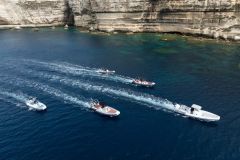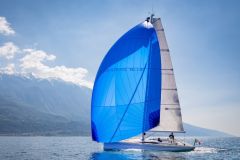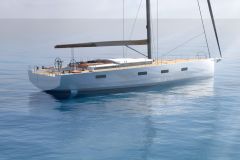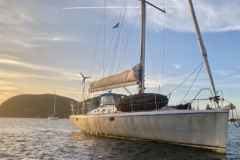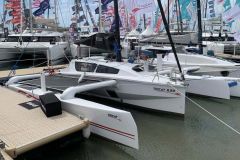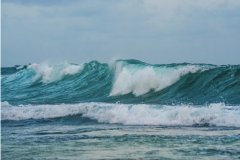Blokart was developed in 1999 by Paul Becket, an aeronautical engineer from New Zealand who was looking to create a fun, fast and compact"wind powered toy". An important criterion for him was that this device should be suitable for all audiences. Jérôme Cottet, Blokart's exclusive importer, explains"Jérôme Cottet He wanted a sand yacht that would suit his whole family, whether it was his strong son, his very young wife or his disabled daughter. He's a pure New Zealander at heart who doesn't embarrass himself with constraints."
He then created a one-design, dismountable, small sand yacht that could be stored in a trunk, a"serious toy". The Blokart is 1.50 metres long and can be driven on the handlebars, unlike other sand yachts which can be driven by foot. " There's no seat length, no foot adjustment, it's a sand yacht for everyone."
In 2002, it was a true success story for the New Zealanders, who were inspired by the concept of 20th century sand yachts. " The sand yachts of the time had 4 wheels and a handlebar. Blokart has returned to the origins."

Blokart, leader on the French market
The arrival of Blokart on the French market was a bit complicated, as Jérôme explains. " 12 years ago, we arrived on a conservative market with a very small engine and the sand yachting industry did not accept us at all. People didn't know the Blokart and they thought that because of its small size it wasn't suitable at all, it was more like a toy."
But eventually, the sauce took over and then over the last 12 years, 11,000 Blokart tanks were sold worldwide. The Seagull leader sells 200 to 250 tanks per year. " We surpassed the leader." jérôme adds proudly.
A fun and easy to use sailing tank
Jérôme explains this success" Blokart is shared with the whole family, i.e. you can mix both leisure and family, everyone can do the same sport. We can also include friends and get together. It is a sand yacht which gathers all the public. People with disabilities can use the same Blokart as people with disabilities, no adjustments to make."

In addition, the Blokart is quite light - 27 kg - and is transported in a bag of 1.20 m by 90 cm wide. " You can store it in a car trunk, in an airplane hold, it's easily transportable." For comparison, a basic sail tank weighs between 50 and 90 kg and measures 2.50 metres in span. It is difficult to transport and requires a trailer.




A regatta sand yacht..
With the success of the sand yacht, the New Zealanders began to write racing rules in order to organize Blokart events. " The rules are pretty simple, they're free of all constraints, the goal is to have fun." As of 2005, the rules indicate that at the start of the race, all drivers must be in their Blokart and must not leave it. " So, disabled and able-bodied can compete together, everyone is on the same pedestal" explains Jérôme.
In France, in Saint-Malo, Jérôme organizes the 1 er blokart World Championship in 2005. " Today, 11,500 Blokart are one designs, which allows drivers to race evenly." says Jerome. Subsequently, 23 race classes were created: production and performance. The first is standard and the second can be enhanced with options.
"The next world championship will be held in 2016 in the Nevada desert. It is an open competition and anyone can participate with a standard Blokart. They are in the New Zealand spirit and take place in a good-natured manner, with lots of fun, fair play..."
... And friendly gatherings
For all that, the Blokart remains above all a leisure machine" Less than 5% of drivers are interested in the competition. The vast majority of owners use them occasionally. We're having a hard time federating the pilots. They are between 800 and 900 in France but only a hundred gather." Because, indeed, the ease of use of the Blokart also makes it a sand yacht that can be used alone in its corner and not necessarily in a club. " You keep it in your garage, when you want to make it, you transport it, you assemble it in 5 minutes and you practice. Even children from the age of 6 can practice on their own. It's something very accessible." What is very popular, on the other hand, are the"challenge concentrations". " People meet for walks of 15 km. They are a huge success because they are informal meetings but in which we induce a kind of competition because having all the same, we try to see who will have the best performances. It's natural."

When Blokart is practiced on the roads..
Blokart is mainly practiced on beaches, mainly outside the summer period "In summer the beaches are regulated but free in winter." Some even practice on the land and others have outright diverted the use of the sand yacht to make a"karting sail".
" Some practice this sport in-land because its driving is similar to karting. Paul Becket had a 60 x 20 track built in front of the Blokart factory for people who found it too hard to drive on sand. In 2008, the first world championships were held there. Blokart drives a bit like a kart, aggressively and New Zealanders are used to driving on asphalt." On the French side, the practice is only very little widespread In France, the sand yacht is associated with the northern beaches and the large estates. They're not used to riding on asphalt and are afraid of change, it's typically French."

Blokart to travel the world
Thanks to its ease of transport, the Blokart can be taken anywhere in the world and this is what several French adventurers have done. " A former journalist of France 3 went to the Gobi desert in Mongolia in 2006, I went to Niger to organise the crossing of the country, others crossed the Atacama desert in Chile, rallies in the Nevada desert, two sail tank instructors went on a tour of South America..."
The Belgian anthropologist, Xavier Van der Stappen, carries out the operation Dakar No Oil and connects Tangier to Daker in Blokart. A Franco-Spanish team crossed the Ténéré desert. "This video has made many people dream and inspired many vocations."

